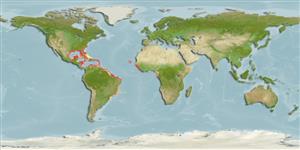Common names from other countries
Issue
Molecular studies by Craig & Hasting (2007: Ref. 83414) and Ma et al. (2018: Ref. 119507) placed this species in the genus Cephalopholis.
Environment: milieu / climate zone / depth range / distribution range
Οικολογία
Θαλασσινό(ά) Υφαλόφιλο(α); εύρος βάθους 8 - 100 m (Ref. 9710), usually 10 - 66 m (Ref. 13442). Subtropical; 35°N - 28°S, 98°W - 10°E (Ref. 5222)
Eastern Atlantic: Ascension Island and Gulf of Guinea islands of Principe, São Tomé, and Annobon. Western Atlantic: Bermuda, Florida, Gulf of Mexico, Campeche Bank, and throughout the Caribbean (except in northern Bahamas) to Sao Paulo, Brazil.
Μέγεθος / Βάρος / Age
Maturity: Lm ? range ? - ? cm
Max length : 30.0 cm SL αρσενικό/απροσδιόριστο; (Ref. 26938); common length : 20.0 cm TL αρσενικό/απροσδιόριστο; (Ref. 2739)
Ραχιαίες άκανθες (συνολικά) : 9; Μαλακές ραχιαίες ακτίνες (συνολικά) : 17 - 19; Εδρικές άκανθες: 3; Μαλακές εδρικές ακτίνες: 8 - 10. Distinguished by the following characteristics: Head short (less than 35% of SL) (Ref. 26938); head and body reddish brown, paler ventrally; bright orange-red spot at the upper end of the pectoral-fin base; 3 widely spaced white spots between lateral line and dorsal-fin base; 2 blue lines on the cheek, one approximately horizontal and tangential to the lower edge of the eye, other along the upper edge of maxilla and continued onto the lower part of the cheek; depth of body contained 2.9-3.4 times in SL; subangular preopercle, vertical edge and rear half of lower edge finely serrate; subequal posterior and anterior nostrils (Ref. 89707).
Inhabits coral reefs and hard bottom areas. Observed in feeding aggregations well above the reef. Feeds mainly in midwater on zooplankton (copepods, pelagic tunicates, shrimps and shrimp larvae). Retreats instantly when alarmed (Ref. 9710).
Life cycle and mating behavior
Maturities | Αναπαραγωγή | Spawnings | Egg(s) | Fecundities | Προνύμφες
Heemstra, P.C. and J.E. Randall, 1993. FAO Species Catalogue. Vol. 16. Groupers of the world (family Serranidae, subfamily Epinephelinae). An annotated and illustrated catalogue of the grouper, rockcod, hind, coral grouper and lyretail species known to date. Rome: FAO. FAO Fish. Synop. 125(16):382 p. (Ref. 5222)
IUCN Red List Status (Ref. 130435)
CITES (Ref. 128078)
Not Evaluated
Threat to humans
Harmless
Human uses
αλιεία: παραδοσιακή αλιεία; Ενυδρείο: Εμπορικό(ά); δόλωμα: usually
Εργαλεία
Special reports
Download XML
Διαδικτυακές πηγές
Estimates based on models
Preferred temperature (Ref.
115969): 21.2 - 28, mean 26.1 (based on 704 cells).
Phylogenetic diversity index (Ref.
82804): PD
50 = 0.7500 [Uniqueness, from 0.5 = low to 2.0 = high].
Bayesian length-weight: a=0.01148 (0.00558 - 0.02364), b=3.04 (2.88 - 3.20), in cm Total Length, based on LWR estimates for this (Sub)family-body shape (Ref.
93245).
Τροφικό Επίπεδο (Ref.
69278): 3.2 ±0.1 se; based on diet studies.
Ελαστικότητα (Ref.
120179): Μεσαίο(α), ελάχιστος χρόνος για διπλασιασμό πληθυσμού 1,4 - 4,4 έτη (K=0.22-0.28).
Prior r = 0.44, 95% CL = 0.29 - 0.66, Based on 1 data-limited stock assessment.
Fishing Vulnerability (Ref.
59153): Moderate vulnerability (38 of 100).
